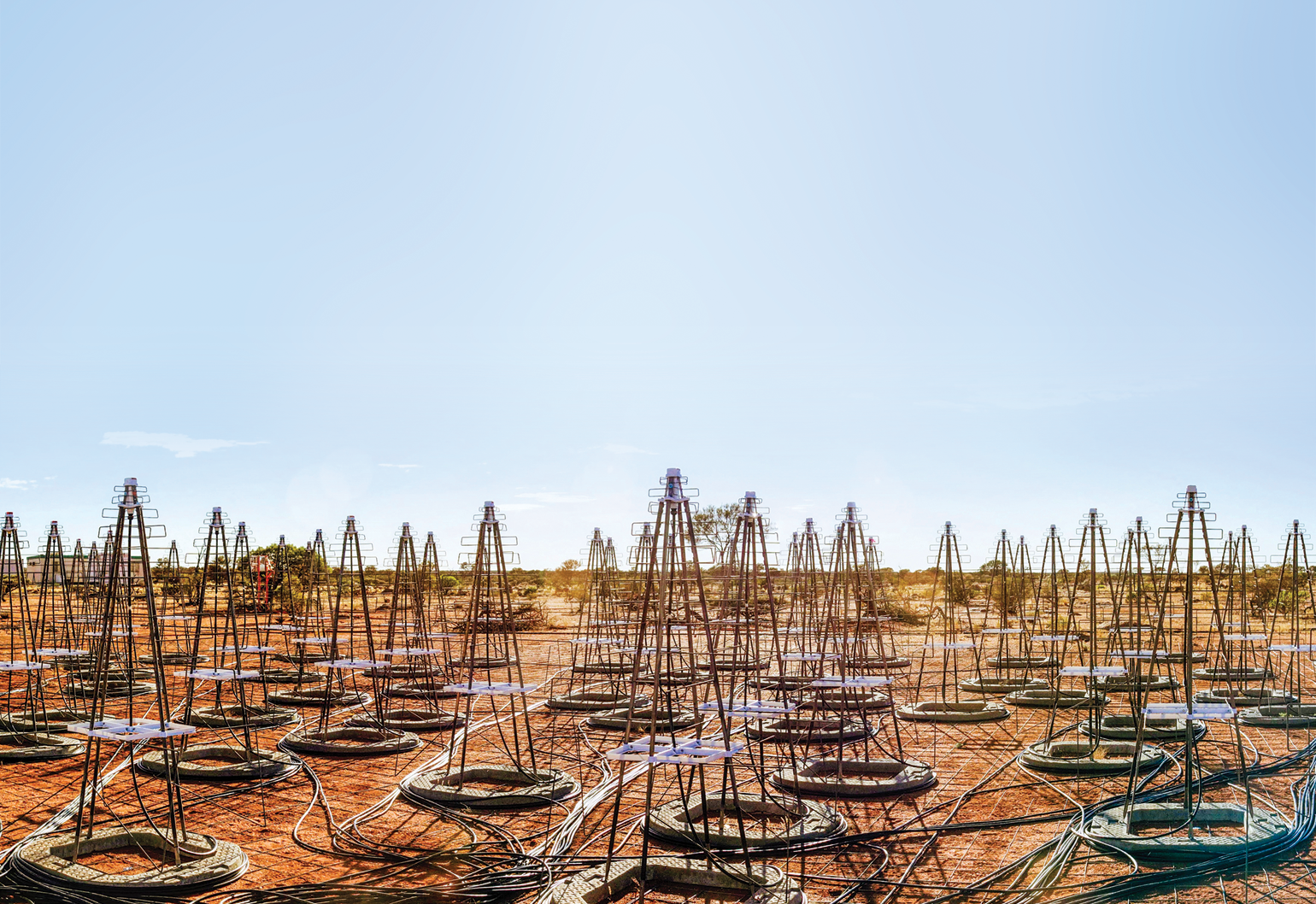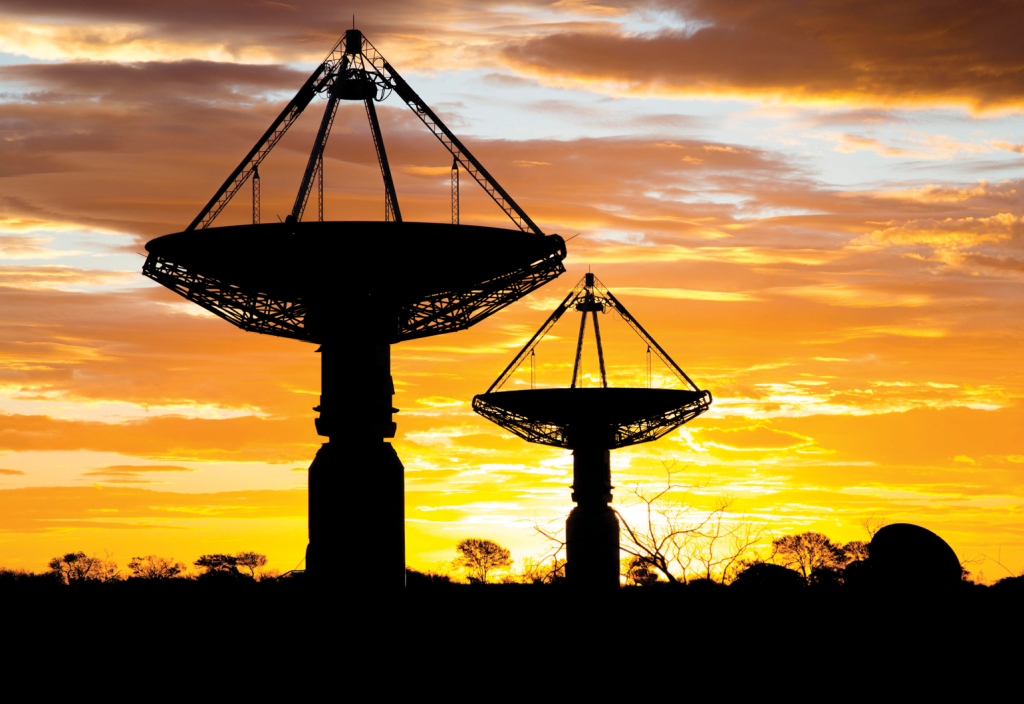In WA’s remote Murchison region, engineers and astrophysicist are toiling away on the groundwork for the world’s largest radio telescope project.
Visitors to Western Australia’s Murchison region could be forgiven for thinking Christmas has come early to the state’s midwest.
Amid the sun, soil and vast expanses sit a handful of buildings and about 100 antennas that stand at about head height and resemble Christmas trees. Far from sporting tinsel or festive baubles, these devices represent the latest precursor technology to the Square Kilometre Array (SKA) which is an international effort to build the world’s largest radio telescope.
Widely touted as the biggest science project ever attempted, the SKA will allow astronomers to see the first ever stars and survey galaxies faster and at far greater sensitivity than any existing radio telescope.
The project will eventually answer some of science’s biggest questions such as testing Albert Einstein’s Theory of General Relativity and understanding dark energy.
The SKA consortium is made up of 10 member countries which have collectively contributed €674 million to make the project a reality.
SKA will be co-located in South Africa’s Karoo district with the Western Australian component of the project, known as SKA-low, observing radio waves with frequencies between 50 and 350 MHz.
The first phase of SKA-low will take the form of 130,000 Christmas tree-like dipole antennas which will sit stationary in CSIRO’s Murchison Radio-astronomy Observatory
The site already hosts SKA forerunner platforms the Australian Square Kilometre Array Pathfinder (ASKAP) and the Murchison Widefield Array (MWA).
Groups of 16 dipole antennas collectively make up a single tile with 16 of those tiles making up a single station. Eventually 75 per cent of the devices will sit in a densely packed core measuring 2 km in diameter, with the remaining antennas stretching out on three spiral arms at a radius of 40 km.

Current activities by researchers at the International Centre for Radio Astronomy Research (ICRAR) are focused on a smaller-scale testbed platform known as the Aperture Array Verification System (AAVS).
AAVS is being delivered as a joint effort by experts from seven different countries who are being led by researchers from the Netherlands Institute for Radio Astronomy (ASTRON).
Once it is complete, AAVS will consist about 400 dipole antennas designed to test the prospective design for SKA-low while negotiations are underway to construct SKA in the coming years. So far, an international team of engineers has installed about 100 AAVS antennas at the Murchison Radio-astronomy Observatory.
ICRAR acting Director of Engineering Operations Tom Booler said once the signal hits the antenna structure it is strengthened by a low noise amplifier so it can then be transmitted for processing.
“That low noise amplifier puts the signal into a laser driver and that laser transmits it on fibre to a central processing building…and at that point the signals from every single antenna in AAVS get digitised,” he said.
Once the signals are digitised, a number of signal aggregation and processing activities take place before the information is piped all the way to Perth for archiving in the Pawsey Supercomputing Centre. From there the data is accessed and used by engineers and astrophysicists from around the world.
Maintaining signal integrity
ICRAR research engineer Dr Budi Juswardy is responsible for characterising the radio frequency front-end parts of the AAVS array. In other radio astronomy projects, electrical cables are used to transmit signals from the antenna to the receiver but for the AAVS project we are using fibre optics, he tells create.
“Fibre optic links enable us to transmit signals up to 5 km which has low loss compared to carrying signals using electrical cable,” he said.
But the difficulty with using fibre optics, according to Dr Juswardy, is maintaining the stability of the laser wavelength and assessing phase variations caused by temperature changes.
“When the phase of the transmitted signals across an array varies over the time, the resulting radiation pattern we’re forming on the sky is distorted, so we need to accurately characterise the error contributions from the fibre optics and try to minimise the impact,” he said.
Juswardy is also responsible for characterising the low noise amplifier in the antennas in terms of their radio frequency performance. He said we need to ensure our radio receiver instrumentation produces as little radio noise as possible and be confident that the data being captured is the real measurement from the sky and not contributions or distortions from our instruments.
Curtin University Associate Professor and MWA Director Randall Wayth told create that SKA-low will generate a mind boggling amount of data once it starts operations.
“We’re capturing and digitising the raw radio signal from every single antenna in the array so that is 130,000 antennas times two polarisations,” Wayth said.
“Then we are talking about digitising and processing that entire full-bandwidth
digital signal into the system. In terms of the raw data rate we are digitising 131,000 antennas at 300 MHz worth of bandwidth with eight bits per sample, an astonishing data rate.”
Beamforming reduces dataflow
The scientists have ways to reduce the rate of data capture to make the process more manageable by manipulating each SKA-low station to view different points in the sky.
While the antennas cannot physically turn like ASKAP’s parabolic dishes, the scientists can apply an electronic delay to each individual antenna in the station to electronically steer the station’s response, known as a ‘beam’, on the sky.
This process is known as beamforming and is the first step in reducing the raw data rate. The beams from each station are brought together in a correlator, which is the heart of the signal processing system in the radio array.
“In the correlator you get some time averaging that reduces the data rate down again to be something that is manageable,” Wayth said.
It is hoped that one day each SKA-low station will be able to beamform independently.
Logistical challenges
Booler said they learnt a lot from the first AAVS deployment campaign in March.
“There are a whole bunch of lessons learnt from AAVS already in terms of how to ship, handle, transport and even manufacture…the antennas and other components of the system,” he said.
The first AAVS antennas were transported from the UK by sea. However, due to quality control issues when the antennas were coated to prevent corrosion, a number of antennas exhibited signs of rusting from the salty environment during transit.
“Until you exercise a realistic supply chain you do not encounter a variety of issues, ranging from technical to logistics and deployment. From that point of view AAVS has already been a wild success,” he said.
Testing the antennas in the Murchison has provided the first opportunity to properly assess the equipment’s sensitivity with the Murchison Radio-astronomy Observatory devoid of radio interference compared to large cities.
Maintaining the pristine radio quiet environment of the site is one of our key priorities – the MRO is one of the most accessible, radio-quiet locations in the world and we need to preserve that, Booler said.
There is a significant amount of electronics involved in all these things, especially the central building which houses the computers and which must be shielded like a tank.
Each antenna also houses multiple electronic components which won’t affect the antenna itself but may interfere with those around it if it doesn’t function properly.
“The actual signals the scientists are interested in are so weak that any terrestrial signals are just going to clobber it,” he said.
Once SKA-low is up and running, the scientists hope to use the technology to detect and measure the very faint radio signals emitted from neutral hydrogen gas left over from the very early universe.
Wayth said from a few hundred million years to a billion years after the Big Bang there were no stars and so scientists know nothing about this epoch as it can’t be studied by a conventional telescope.
“During this time the universe was filled with hydrogen and hydrogen gas emits a radio wave with a known frequency and it is really faint,” he said.
“If we can detect and study that signal it will tell us everything there is to know about both the large scale properties of the early universe and the properties of individual galaxies.”
For these guys that result would be the best Christmas present of all.
This article originally appeared as “Eye on the sky” in the November 2017 issue of create magazine.
